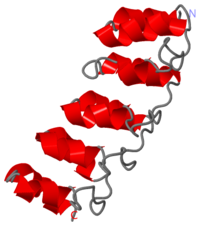Michael Purol Sandbox 1
From Proteopedia
Contents |
CDK Inhibitor p19INK4d
| |||||||||
| 1bd8, resolution 1.80Å () | |||||||||
|---|---|---|---|---|---|---|---|---|---|
| |||||||||
| |||||||||
| Resources: | FirstGlance, OCA, RCSB, PDBsum | ||||||||
| Coordinates: | save as pdb, mmCIF, xml | ||||||||
p19INK4d in the Cell Cycle
CDK Inhibitor p19INK4d is a cyclin-dependent kinase (CDK) inhibitor in the INK4 family of CDK inhibitors, which includes p16INK4a, p15INK4b,and p18INK4c. Progression through the G1 phase of the cell cycle and subsequent entry into the S phase depend on the phosphorylating effects of CDK4 and CDK6. These two CDKs must form cyclin-CDK complexes to phosphorylate the retinoblastoma protein, inhibiting its growth-suppressing function, and triggering an E2F-dependent transcriptional program necessary for entry into S phase. The INK4 family members specifically bind to CDK4 and CDK6, inhibiting cyclin-CDK complexation and obstructing the progression of G1 phase.
To view p19INK4d bound to CDK6, click here:
p19INK4d Structure
The four INK4 proteins share a similar sturcture consisting of either four (p15 & p16) or five (p18 and p19) ankyrin repeats (AR). The binding interactions between p19INK4d and CDK4/6 occur primarily at AR 1 and AR2. Phosphorylation sites of p19INK4d have been identified at and , and Ubiquitination ligase has been found to attack the position. [4]
Cancer
Loss of INK4 gene product function, particularly that of p16(INK4a), is found in 10-60% of human tumors, suggesting that broadly applicable anticancer therapies might be based on restoration of p16INK4a CDK inhibitory function. Although much less frequent, defects of p19INK4d have also been associated with human cancer (osteosarcomas). [1] In human osteosarcomas, p19INK4d function has been found to be altered by phosphorylation at Ser 66 and Ser 76 and ubiquitination at Lys 62. [5]
Cancer Prevention
In a 2005 study by Ceruti et al., researchers determined that in addition to and perhaps even independent of its role as a cell cycle inhibitor, p19INK4d is involved in the maintenence of DNA integrity and, therefore, would contribute to cancer prevention. [3] This study shows that p19INK4d is the only INK4 protein whose expression is induced by UV light in neuroblastoma cells, and that this expression clearly reduces UV-induced (DNA-damage-induced) apoptosis by enhancing cellular ability to repair damaged DNA. [3]
Low et al. (2009) Study
This study took an in-depth look at the structural consequences of phosphorylation at different sites of p19INK4d. Low et al. replaced Phe 86 with a trytophan residue which acted as a fluorescence-sensitive probe within a pseudo-wild type (in stability and function) mutant that displayed a hyperfluorescent intermediate which could be detected in unfolding and folding kinetics, but not at equilibrium conditions.
Researchers then mimicked known phosphorylation sites with glutamate substitutions at and within E. coli to test the impact of introduced negative charges at these positions on the structural stability of P19INK4d. Results indicated that mutants with the glutamate substitutions at Ser 76, as well as mutants with glutamate substitutions at both Ser 66 and 76, were significantly destabilized in comparison to the wild-type protein, while mutants with only a Ser 66 glutamate substitution showed no significant destabilization. In particular, the results supported earlier findings that a negative charge at Ser 76 severely decreases protein stability in AR1 and AR2 by affecting the hydrogen bonding pattern of the adjacent residues, leading to a partial unfolding reaction and higher flexibility in the loop. These findings suggest that phosphorylation or mimetic mutation at Ser 76 position allows ubiquitin ligase to more readily access and thus tag p19INK4d for degradation at the proteasome. [4]
About this Structure
1BD8 is a 1 chain structure of sequence from Homo sapiens. Full crystallographic information is available from OCA.
Additional Resources
For additional information, see: Cancer
References
[1] Baumgartner R, Fernandez-Catalan C, Winoto A, Huber R, Engh RA, Holak TA. (1998). Structure of human cyclin-dependent kinase inhibitor p19(INK4d): comparison to known ankyrin-repeat-containing structures and implications for the dysfunction of tumor suppressor p16(INK4a). Structure with Folding & Design 6,1279-1290.
[2] Brotherton DH, Dhanaraj V, Wick S, Brizuela L, Domaille PJ, Volyanik E, Xu X, Parisini E, Smith BO, Archer SJ and others. (1998). Crystal structure of the complex of the cyclin D dependent kinase Cdk6 bound to the cell-cycle inhibitor p19(INK4d). Nature 395,244-250.
[3] Ceruti JM, Scassa ME, Flo JM, Varone CL, Canepa ET. (2005). Induction of p19INK4d in response to ultraviolet light improves DNA repair and confers resistance to apoptosis in neuroblastoma cells. Oncogene 24,4065-4080.
[4] Low C, Homeyer N, Weininger U, Sticht H, Balbach J. (2009). Conformational Switch upon Phosphorylation: Human CDK Inhibitor p19(INK4d) between the Native and Partially Folded State. Acs Chemical Biology 4,53-63.
[5] Thullberg M, Bartek J, Lukas J. (2000). Ubiquitin/proteasome-mediated degradation of p19(INK4d) determines its periodic expression during the cell cycle. Oncogene 19,2870-2876.


